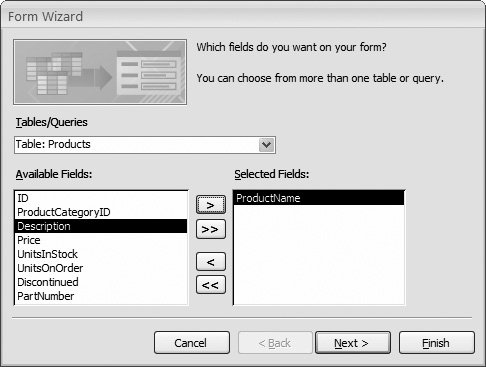12.4. The Form Wizard By now, you've learned how to create a number of common forms. Access gives you one other way to build a form: using the Form wizard . The Form wizard has an uncanny similarity to the report wizard you used in Chapter 10. It asks you a series of questions and then builds a form to match. However, the questions are fairly rudimentary, and the form it builds is little more than a good starting point for further customization. Here's how to put the Form wizard through its paces: -
Choose Create  Forms Forms  More Forms More Forms  Form Wizard . Form Wizard . The first step of the Form wizard appears. -
From the drop-down list, choose the table you want to use . In the Available Fields list, the wizard shows all the fields that are in your table. -
Add the fields you want to include, as shown in Figure 12-20. When you're finished, click Next . You can choose fields from more than one table, provided these tables are related .  | Figure 12-20. To add a field, select it, and then click the > button to move it from the Available Fields list to the Selected Fields list. To add all the fields, click >>. | | -
Choose a layout option for your form . Your layout options include:
Note: Justified forms are difficult to modify later on. For example, if you need to add a field into the middle of a layout form, you're stuck with the painstaking task of moving many more fields out of the way to new positions . Often it's easier to recreate the form from scratch using the wizard.
-
Choose one of the preset styles, and then click Next . The styles determine the formatting that Access applies to your form. Unfortunately, it's difficult to get a feeling for what the final result will look like unless you actually try each option. -
Enter a name for your form . When the Form wizard finishes, it immediately saves your form using this name. -
Choose " Open the form to view or edit information" if you want to start using your form to work with data, or "Modify the form's design" if you want to adjust it in Design view first. Then, click Finish . Access saves your form and opens it in Form view or Design view, depending on your choice. |
 Forms
Forms 